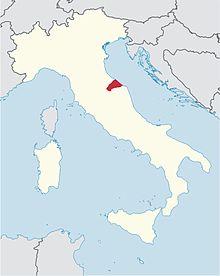History
The patron saint of Senigallia is a St. Paulinus, whose remains are said to be preserved in the cathedral (as is attested for the first time in 1397). There is no evidence that he was ever a bishop. [3] He is, therefore, not identical with Paulinus of Nola, nor is it known to what epoch he belongs. The first bishop of certain date was Venantius (502).
Under Bishop Sigismundus (c. 590) the putative relics of St. Gaudentius, Bishop of Rimini and martyr, which had mysteriously been transported by sea, were brought to Senigallia.
In the 1050s, the bishop of Fossombrone complained to Pope Victor II (1054–1057) about the poverty of his diocese. In reply the pope granted him the church of S. Giovanni in Sorbitulo, with all of its property and income, as well as spiritual jurisdiction. The grant was immediately contested by Guglielmo, Bishop of Senigallia, and the litigation continued until 15 May 1070, when it was settled in favor of Fossombrone by Pope Alexander II, who confirmed the transfer of the church of S. Giovanni as well as the other churches in the massa Sorbituli. Senigallia therefore lost a not inconsiderable territory and income. [4]
In 1264, King Manfred of Sicily, the son of the Emperor Frederick II, was fighting against a "Crusade" organized by Pope Urban IV and the son of King Louis VIII of France, Charles of Anjou, to overthrow him. To assist him he brought in Saracen troops from south Italy and north Africa. Under the command of Percivalle Doria, these joined with the Ghibbelines of Senigallia in furious fighting and acts of revenge which left the city of Senigallia and all of its larger buildings in ruins. [5] Bishop Jacopo rebuilt the cathedral which had been destroyed by the troops of King Manfred. It was consecrated by Bishop Filippo on 4 May 1271. [6]
Schism of 1328–1330
In 1328, Senigallia became involved in the fourteen-year-long feud between Pope John XXII, who had supported Frederick von Hohenstaufen for the dignity of Holy Roman Emperor, and Louis of Bavaria, who defeated Frederick in war and successfully claimed the dignity. In vengeance, Pope John excommunicated him, and harassed him and his followers. In 1327, the Emperor Louis IV visited Italy, where he was crowned King of Italy at Milan on 31 May 1327. That winter he visited Rome, where he was recognized as Emperor and crowned on 17 January 1328, with the staunch and vocal opposition of the Guelph party. The Pope pronounced the coronation void, excommunicated Louis again, and ordered a Crusade against him. Louis replied by holding a parliament on 14 April and on 18 April, and had the Pope declared a heretic and deposed. A new pope was elected, the Franciscan Pietro Rinalducci (Rainalducci), who was called Nicholas V. [7]
Nicholas and Louis began to take over the Church in Rome, central and northern Italy, and in Bavaria. Nicholas appointed seven cardinals, and attracted the bishops of Milano, Cremona, Como, Ferrara, Savona, Albenga, Genoa, Pisa, Lucca, Pistoia, Volterra, Arezzo, Borgo Sansepolcro, Bologna, Città di Castello, Viterbo, Todi, Bagnorea, Camerino, Osimo, Fermo, Urbino, Jesi, Fabriano, and Matelica to his schism. [8] He also appointed new bishops for Osimo (Conradus Theutonicus, O.E.S.A.), Fermo (Vitalis of Urbino, O.Min.), and Senigallia (Thomas de Rocca of Matelica, O.E.S.A.). [9]
To counter the schismatic advances in the March of Ancona, Pope John XXII, who had transferred Bishop Frederick of Senigallia to the diocese of Rimini (21 October 1328), [10] on 7 November 1328 promoted the Franciscan, Giovanni of Ancona, the papal Inquisitor in the Marches of Ancona, to the diocese of Senigallia. In addition, in a letter of 25 January 1329, the Pope continued Bishop Giovanni in his office of Inquisitor of the March of Ancona, authorizing his powers to extend far beyond the diocese of Senigallia. [11] The schism began to dissipate with the departure of Louis IV for Germany in April 1329, and then the surrender of Nicholas V to papal authorities in August 1330. [12]
Suffragan
From time immemorial, the bishops of Senigallia had been directly subordinate (suffragans) of the Holy See (Papacy), with no supervisory archbishop intervening. But in 1563 the situation was altered. In his bull Super universas of 4 June 1563, Pope Pius IV reorganized the administration of the territories of the March of Ancona by creating a new archbishopric by elevating the bishop and diocese of Urbino. He created the new ecclesiastical province of Urbino, which was to include the dioceses of Cagli, Pesaro, Fossombrone, Montefeltro, Gubbio, and Senigallia. [13]
From 1563 to 2000, therefore, the diocese of Senigallia was a suffragan of the archdiocese of Urbino. On 11 March 2000, by virtue of the Bull Quo maiori, Pope John Paul II created the new ecclesiastical province of Ancona-Osimo, and assigned it the dioceses of Fabriano-Matelica, Jesi, Loreto, and Senigallia [14]
Cathedral and Chapter
In 1417, galleys and troops supplied by Galeazzo Malatesta of Pesaro and Carlo Malatesta of Rimini attacked Senigallia, as part of their plan to dominate the entire March of Ancona, and, with intermissions, held it under their control. [15]
Under Bishop Antonio Colombella (1447–1466), Sigismondo Pandolfo Malatesta, lord of Senigallia and Rimini, made major efforts to improve the fortifications of the city of Senigallia, beginning in 1453. This involved the destruction of some properties belonging to the bishop in order to construct towers at appropriate strategic places, over which Bishop Colombella refused to compromise or cooperate. The flash-point was reached in 1456, when the Tower of S. Bartolomeo was begun opposite the episcopal palace. Angered by the Bishop's resistance, Malatesta caused the cathedral and the episcopal palace to be demolished. The precious materials were transported to Rimini and were used in the construction of the Tempio Malatestiano (San Francesco). [16] Discussions in Rome following these events suggested that the diocese of Senigallia be united with the diocese of Jesi, but they never progressed beyond talk. [17] Without a proper cathedral, Bishop Marco Vigerio della Rovere (1513–1560) moved his seat to the church called the Prepositura, where regular cathedral services, abandoned for a half century, were resumed. [18]
A new cathedral was begun in 1540 under Bishop Marco Vigerio Della Rovere; it was consecrated in 1595 by Bishop Pietro Ridolfi (1591–1601). In 1682, when Senigallia was under the direct temporal dominion of the Holy See (Papacy), the cathedral of S. Pietro was served by a Chapter composed of three dignities and seventeen Canons. [19] The dignities were: the Archpriest, the Provost, and the Archdeacon. The eight senior Canons were called the Antiqui, and were alternately appointed by the pope and the bishop when a vacancy occurred. Two other Canons were de jure Patronatus, and were appointed by the persons holding the right of patronage. The remaining ten, called Locatelli, were elected by the Council and Senate of the city, from the members of the nobility. On the cathedral staff there were also six mansionarii, elected likewise by the Council and Senate. [20]
Synods
A diocesan synod was an irregularly held, but important, meeting of the bishop of a diocese and his clergy. Its purpose was (1) to proclaim generally the various decrees already issued by the bishop; (2) to discuss and ratify measures on which the bishop chose to consult with his clergy; (3) to publish statutes and decrees of the diocesan synod, of the provincial synod, and of the Holy See. [21]
Bishop Pietro Ridolfi (1591–1601) presided over a diocesan synod held in the cathedral on 4 May 1591; its decrees were published. [22]
Bishop Antonio Barberini (1625–1628) held a diocesan synod in Senigallia in 1627. [23] The constitutions of that synod were republished and amplified by Bishop Rizzardo Isolani (1734–1742) in his diocesan synod of 29 June 1737. [24]

The Archdiocese of Ancona–Osimo is a Latin Church ecclesiastical territory and metropolitan see of the Catholic Church in the Marche region of Italy.

The Archdiocese of Florence is a Latin Church metropolitan see of the Catholic Church in Italy. It was traditionally founded in the 1st century, according to the 14th century chronicler Giovanni Villani. The diocese was directly subordinate to the Holy See (Papacy) until 1420.

The Diocese of Nola is a Latin diocese of the Catholic Church in Italy, suffragan of the Archdiocese of Naples. Its seat is the Campanian city of Nola, now a suburb of Naples. Its cathedral is dedicated to the Assumption. The dedication was originally to S. Stephen, the Protomartyr, but after the second reconstruction the dedication was changed to the Assumption. It is traditionally credited with the introduction of the use of bells into Christian worship.

The Diocese of Rimini is a Latin Church ecclesiastical territory or diocese of the Catholic Church in Emilia Romagna, Italy. From earliest times, it was a suffragan to the Holy See, despite repeated attempts by the Diocese of Ravenna to claim it as a suffragan diocese. Since 1604, however, it has been a suffragan of the Archdiocese of Ravenna-Cervia.

The Roman Catholic Diocese of Ferentino existed until 1986, when it was united into the new diocese of Frosinone-Veroli-Ferentino.

The Diocese of Rieti is a Latin Church ecclesiastical territory or diocese of the Catholic Church in Italy. It is immediately exempt to the Holy See. Its cathedra is in St. Mary Cathedral in the episcopal see of Rieti.
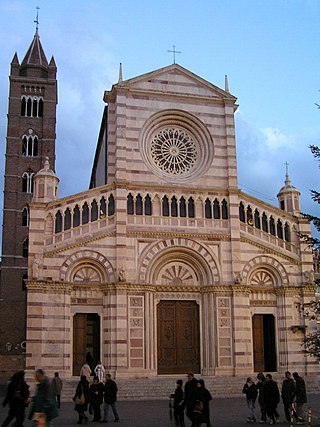
The Diocese of Grosseto is a Latin Church diocese of the Catholic Church in Italy, a suffragan of the archdiocese of Siena-Colle di Val d'Elsa-Montalcino, in Tuscany. Its current bishop is Giovanni Roncari, OFMCap.
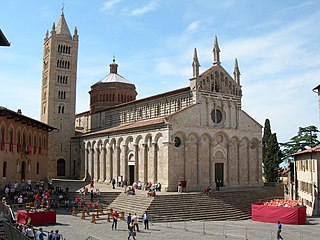
The Diocese of Massa Marittima-Piombino is a Latin Church diocese of the Catholic Church in Tuscany, central Italy. It was known as Diocese of Massa Marittima before 1978. Up until 1458, it was a suffragan of the archdiocese of Pisa; since 1458, it has been a suffragan of the Archdiocese of Siena. The territory of the diocese includes the islands of Elba and Pianosa, and Capraia.

The Diocese of Pitigliano-Sovana-Orbetello is a Latin Church diocese of the Catholic Church in the ecclesiastical province of the Metropolitan Archdiocese of Siena-Colle di Val d'Elsa-Montalcino, in Tuscany. The diocese of Sovana had originally been directly dependent upon the Holy See, and its bishops attended the pope's synods. When Pope Pius II, who was a Piccolomini of Siena, created the metropolitan archdiocese of Siena, he made Sovana one of its suffragan dioceses. The bishops of Sovana usually resided in the former palace of the Orsini in Pitigliano, which was given to Bishop Francesco Pio Santi (1776–1789) by the Grand Duke of Tuscany.

The Italian Catholic diocese of Todi existed until 1986, when it was united into the diocese of Orvieto-Todi. Up until that point, the diocese had always been directly dependent on the Holy See.

The Diocese of Orvieto-Todi is a Latin Church ecclesiastical territory or diocese of the Catholic Church in central Italy. It was created in 1986 when the historical Diocese of Orvieto was united to the Diocese of Todi. The Diocese of Orvieto-Todi is immediately exempt to the Holy See and not part of any ecclesiastical province.
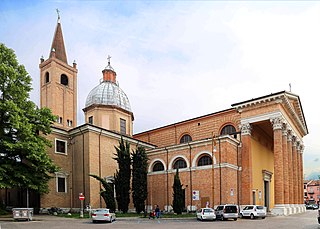
The Diocese of Forlì-Bertinoro is a Latin diocese of the Catholic Church in Romagna, Italy. Until 1986 it was known as the Diocese of Forlì, in existence perhaps from the fourth century. In that year the Diocese of Bertinoro was united to it. The diocese is suffragan to the Archdiocese of Ravenna-Cervia.
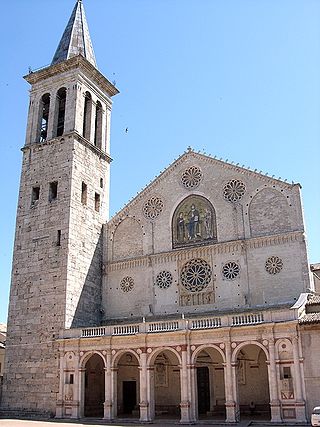
The Archdiocese of Spoleto-Norcia is a Latin Church ecclesiastical territory or archdiocese of the Catholic Church in Italy. Historically, it was the Diocese of Spoleto. Elevated to the status of an archdiocese since 1821, it is a non-metropolitan see and is immediately exempt to the Holy See.

The Diocese of Foligno is a Latin Church ecclesiastical territory or diocese of the Catholic Church in Umbria, Italy. It is a suffragan diocese in the ecclesiastical province of the metropolitan Archdiocese of Perugia-Città della Pieve.
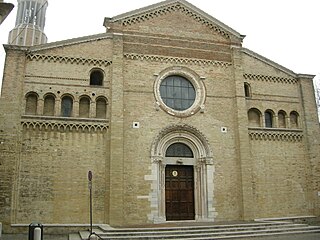
The Diocese of Fano-Fossombrone-Cagli-Pergola is a Latin diocese of the Catholic Church in Italy, created in 1986, when the historical Diocese of Fano was united to the Diocese of Cagli e Pergola and the Diocese of Fossombrone. It is a suffragan of the Archdiocese of Pesaro.
The Catholic diocese of Sarsina was a Roman Catholic ecclesiastical territory in Emilia-Romagna, northern Italy, seated in Sarsina, in the province of Forlì, some 32 km south-southwest of Cesena. The diocese was founded in the 5th century, and was suffragan (subordinate) to the archbishop of Ravenna. The diocese existed until 1986, when it was united with the diocese of Cesena.

The Diocese of Ascoli Piceno is a Latin diocese of the Catholic Church in the Marche. It has existed since the fourth century. Historically immediately dependent on the Holy See, it is now a suffragan of the Archdiocese of Fermo. There is, in 2015, one priest for every 1,074 Catholics.

The Diocese of San Severo is a Latin diocese of the Catholic Church in Apulia. It is a suffragan of the Archdiocese of Foggia-Bovino.

The Diocese of Anagni-Alatri is a Latin Church ecclesiastical territory or diocese of the Catholic Church in Lazio, Italy. It has existed in its current form since 1986. In that year the Diocese of Alatri was united to the historical Diocese of Anagni. The diocese is immediately exempt to the Holy See.

The former Italian Catholic Diocese of Chiusi-Pienza, in Tuscany, existed until 1986. In that year it was united into the Diocese of Montepulciano-Chiusi-Pienza. The Diocese of Chiusi (Clusinus) was at first immediately subject to the Holy See, but was made a suffragan of archdiocese of Siena by Pope Pius II. From 1459 to 1986, it was a suffragan of the archdiocese of Siena.

